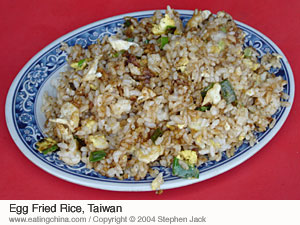Fried rice, a beloved dish enjoyed worldwide, boasts a rich history that spans centuries and continents. Its origins can be traced back to the bustling city of Yangzhou in China, where it emerged as a staple dish during the Sui Dynasty (589-618 AD). The dish’s popularity quickly spread throughout China, becoming a symbol of imperial cuisine and a testament to the region’s culinary prowess.
The Birthplace of Fried Rice: Yangzhou, China
Yangzhou, strategically located at the intersection of the Yangtze River and the Grand Canal, served as a pivotal port city during ancient times. This vibrant hub attracted foreign chefs and merchants, leading to a vibrant exchange of culinary ideas and techniques. The city’s cuisine became renowned for its emphasis on balance, harmony, and the artful presentation of dishes.
It was within this culinary melting pot that fried rice was born. The dish’s simplicity and adaptability made it a favorite among the masses, who utilized leftover rice, eggs, scallions, and vegetables to create a satisfying and economical meal. The addition of oyster sauce or soy sauce further enhanced the flavor profile, while variations emerged to cater to different preferences.
Fried Rice: A Symbol of Longevity and Abundance
In Chinese culture, fried rice holds a special significance beyond its culinary appeal. It is often served as one of the final courses during celebratory banquets, such as weddings, Chinese New Year, and milestone birthdays. This placement symbolizes longevity and the endurance required for a long and prosperous life.
The ingredients used in banquet-style fried rice are carefully selected to convey auspicious meanings. Dried scallops, for instance, represent prosperity, while gai lan stems symbolize long life. The use of egg whites instead of whole eggs imparts an elegant appearance, further enhancing the dish’s celebratory nature.
Fried Rice: A Culinary Bridge between Cultures
As Chinese immigrants ventured abroad, they carried their culinary traditions with them, introducing fried rice to new corners of the globe. In the United States, fried rice became a popular dish in Chinese restaurants, often adapted to suit American palates. However, the commodification of fried rice as a cheap and convenient takeout option somewhat obscured the dish’s rich history and cultural significance.
Despite these challenges, fried rice remains a beloved dish that transcends cultural boundaries. Its versatility allows for endless variations, reflecting the diverse culinary influences that have shaped its evolution. From the simple yet satisfying street food stalls of Asia to the elegant banquet halls of Chinese celebrations, fried rice continues to delight taste buds and connect people across cultures.
Frequently Asked Questions
Q: What country is fried rice from?
A: Fried rice originated in China, specifically in the city of Yangzhou.
Q: What are the key ingredients in fried rice?
A: The basic ingredients of fried rice include cooked rice, eggs, scallions, and vegetables. Variations may incorporate additional ingredients such as meat, seafood, and sauces.
Q: Is fried rice a healthy dish?
A: The healthiness of fried rice depends on the ingredients used and the cooking method. Fried rice made with brown rice, vegetables, and lean protein can be a nutritious meal. However, fried rice made with excessive oil and unhealthy ingredients may not be as beneficial.
Q: What are some popular variations of fried rice?
A: Popular variations of fried rice include:
- Yangzhou fried rice (China)
- Hokkien fried rice (China)
- Nasi goreng (Indonesia, Malaysia, Singapore)
- Khao phat (Thailand)
- Sinangag (Philippines)
- Arroz chaufa (Peru)
Q: What is the significance of fried rice in Chinese culture?
A: In Chinese culture, fried rice is a symbol of longevity and abundance. It is often served as one of the final courses during celebratory banquets, representing the wish for a long and prosperous life.
Great Leftovers The Origin of Fried Rice

Over the decades, many Chinese immigrants have made time for one of the most basic ways we spend our lives together: eating together around a table. This is because they understood that the language of dialed-in care could not take precedence over the chaos of moving to a new place, which is often built around a baseline of survival.
Kenny is a writer and educator living in Los Angeles. The Audacity by Roxane Gay, The Rumpus, LA Downtowner, Thomas Keller’s Finesse Magazine, and the Hammer Museum have all featured his work. He is a writer for KCRW’s Good Food social media, and his handle on Twitter is @kennethjng.
Growing up in the San Francisco suburbs, I spent every Sunday night at dinner with my grandparents. We used to go to the same neighborhood Cantonese restaurant almost every weekend; it was so cozy that my brothers and I would watch “Malcolm in the Middle” in the back room before the food was served.
I can never get rid of the image of a lazy Susan that is always spinning in my head of my grandmother, who was practically silent next to my grandfather, turning a dish in my direction as if to say, “Eat more, this is for you, so eat more.” My grandfather would frequently ask me if we should order more as the second round of dirty plates started to clear because I was the youngest grandchild.
Fried rice is credited with being introduced to the Sui Dynasty by Emperor Yang, who was a great fan of the dish. After China had unified in the sixth century, it was then embraced by the masses and peasants. After nearly four centuries of division, it was a culinary way to use leftovers and prevent waste amid economic inequality.
